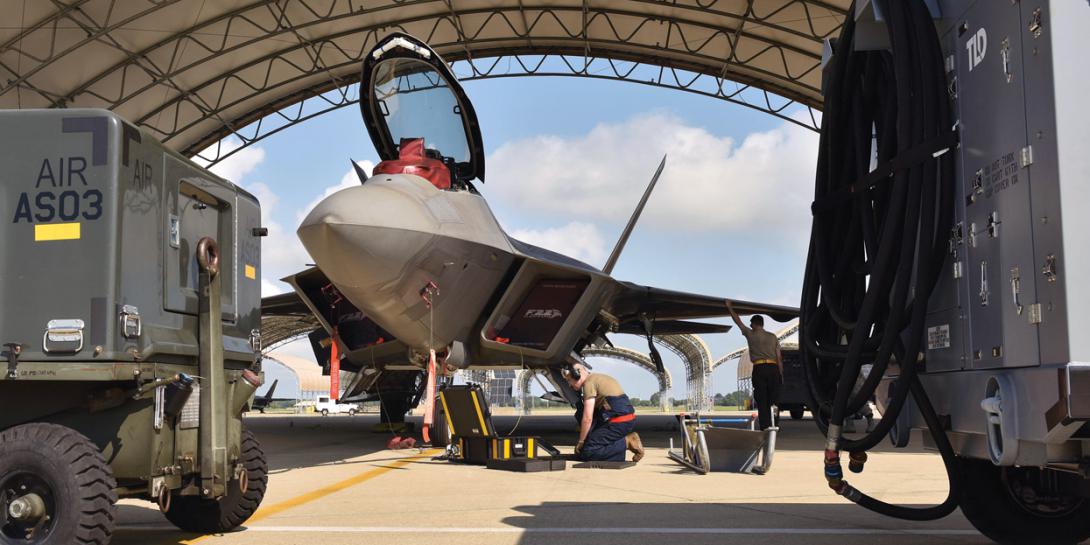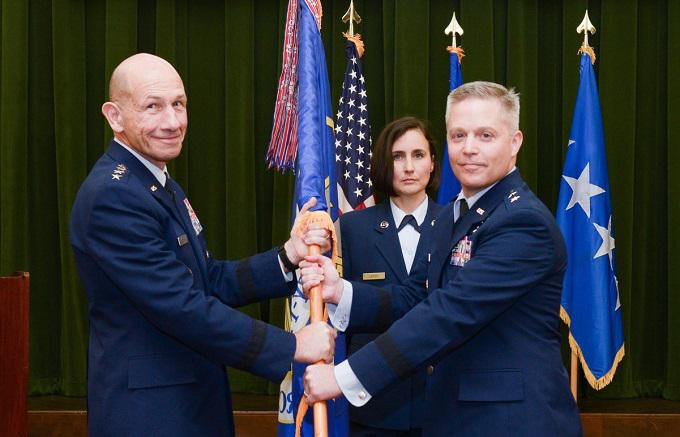Laying the Approach for Future Air Force Operations
On the battlefield of the future, warfighters will need to be extraordinarily interconnected to weapon systems in the air, sea, space, land and digital realms. To support operations across these multiple domains, warfighters will have to rely on advanced command and control capabilities and vigorously employ cyber defenses to its weapons and systems.
As part of its role over the next year, the U.S. Air Force’s Air Combat Command (ACC) is preparing multidomain command and control capabilities, explains Gen. Mike Holmes, USAF, commander, ACC. It is a combined effort across all of the services in the Defense Department, he adds, and as with most things military related, it involves an acronym: JADC2, or Joint All-Domain Command and Control.
“What we’d like to do is be able to connect every sensor, to every shooter, through every command and control center or platform, and that means multidomain sensors,” Gen. Holmes says. “Sensors that are in space, sensors that are in the air, sensors that are on the ground or under the sea—acoustic sensors, magnetic sensors, radar sensors, visual sensors—so every sensor to every shooter in multiple domains, connected to every command and control, whether that’s an air system or ground system or a sea system or undersea system or space system.”
This fall, the service is starting the JADC2 effort at Nellis Air Force Base’s Shadow Operation Center. While all the services will be participating, “we will do at least some of that work at Nellis because we have an existing facility that we can use,” Gen. Holmes shares. “We’re applying Air Force and Joint resources to it to go ahead and get started on our efforts to connect every sensor, every shooter to every command and control node.”
At Nellis, the ACC, with the cooperation of the Joint Staff and their guidance, will look at the Joint Staff’s version of multidomain operations or multidomain command, the general shares. “We don’t have to wait until we build new sensors or new systems that deliver effects,” he notes. “We can start putting those together now and linking them together. The idea is that it’s not just in the Air Force but across the Joint Force.”
The ACC’s effort is part of its continuing focus on readying airmen to provide both kinetic and nonkinetic warfighting effects, including cyber, electronic and information warfare, the general adds. “I think we’ve always had some pretty good game in connecting kinetic and nonkinetic operations,” Gen. Holmes says. “We’ve been doing it for a long time in air operation centers (AOCs) but we think there are ways to do it better and smarter, and there are ways to tie things together in an integrated way so that we can make the effects of the whole greater than the sum of the parts.”
The command began to widen the integration of kinetic and nonkinetic effects almost two years ago, when leaders knew cyber would be incorporated into all of its operations. “We started on our [Air] Staff building an information warfare-focused team at our AF/A-3, when we knew that 24th Air Force was coming over to us,” he offers. “Those guys now are in their second year, and [the effort] is starting to reach some maturity. The division, led by Lt. Gen. Mark Kelly, USAF, deputy chief of staff for operations, Headquarters U.S. Air Force, Arlington, Virginia, created an information warfare integration cell in order “to lay out the plans and lay out a way ahead,” for standing up the Air Force’s newest Numbered Air Force (NAF), the 16th Air Force, Gen. Holmes says.
The Air Force appointed Lt. Gen. (Sel.) Timothy Haugh, USAF, to be the commander of the 16th Air Force, ACC, Joint Base San Antonio-Lackland, Texas. The new NAF will support the Air Force and the U.S. Combatant Commands by providing comprehensive information warfare—cyber, electronic and information warfighting capabilities.
“When they start out, they’ll have our Air Force cyber component and the cyber mission teams that we commit to U.S. Cyber Command,” Gen. Holmes explains. “They’ll have our global integrated intelligence surveillance and reconnaissance (ISR) enterprise, where we both collect data and process that data and present it to the combatant commanders through our service components all over the world. They’ll have the bulk of our dedicated electronic warfare resources. They’ll also continue to serve as our service cryptological component managing the airmen we support into the intelligence community.”
Creating the 16th Air Force was an important step for the Air Force, the general notes. Given the threats and actions from adversaries, all services of the military have quickly moved to create comprehensive information warfare tied to their growing cyber and electronic warfare capabilities.
“We think it is a big deal,” Gen. Holmes confirms. “Part of it is our National Defense Strategy, which reminds us that we’re in competition with great powers, and that competition has a military component that stays, we hope, below the level of armed conflict. But those adversaries, the other great powers, are using all the tools of information warfare. And so if we’re going to allow our national security leaders, our national decision makers to compete, I think we all want to find a way to give them some better information warfare tools.”
And the ACC A-3’s information warfare integration cell is designed to pull all of those warfighting tools together to support information warfare and information operations. “We’re looking at providing the tools and planning expertise that [addresses] how to use all the things that the Air Force presents in information warfare, that then we can provide to the combatant commanders through our service components,” the commander adds.
The restructuring also brings into the new NAF the 557th Weather Wing, Offutt Air Force Base, Nebraska, from the 12th Air Force. The 557th Weather Wing provides key weather intelligence to the U.S. military, the federal government and allies. It will be better suited at the new Information Warfare NAF, the commander asserts.
“I don’t think it will change a lot of their responsibilities, but I think it makes sense because what we ask them to do is gather information about the weather threat to operations and to analyze it and disseminate it out to all the warfighters, which is a lot like what our intelligence surveillance and reconnaissance wings do. They also have a heavy comm [communications] dependence; they use computers and artificial intelligence in that work, and they need to be protected from cyber attacks. So we think it makes sense to line them up in the Information Warfare Numbered Air Force.”
On the cyber defense front, the Air Combat Command also is expanding its mission defense team program, Gen. Holmes noted. On top of other cyber protections, the Air Force, through a full force effort, is employing a persistent cybersecurity model to guard its major weapon systems, in which the Air Combat Command will deploy protective crews to key airborne platforms and infrastructure. These so-called mission defense teams, known as MDTs, will work closely with weapons operators and intelligence leaders to form a specialized cybersecurity platform. The 557th Weather Wing, for instance, already has employed an MDT to help guard its weather intel.
“We started those [MDTs] by taking people from existing [communication] squadrons out in the wings and pulling them away from the other duties they were doing, such as running the network, the help desk or the communications resources that the wing has, to have them focus on cyber defense of the wings’ mission systems,” the commander explains. The MDTs are developing their tactics and techniques, as the command broadens the program. “We continue to expand them, and we’ve now reached the point where we have a formal training unit that’s providing the training they need to operate in those spaces,” Gen. Holmes states.
In particular, the command worked with the Air National Guard and the Air Force Reserve to stand up a training unit for the MDTs. “Our first students are in classes now,” he observes.
Gen. Holmes reasons that the role of the MDTs hinges in part on the success of the Air Force’s enterprise information technology-as-a-service effort, known as EITaaS, which the leader hopes will free up airmen previously providing information technology service. “By contracting out some of the functions at the base level, we’re able to make airmen available to do the mission defense team work,” the general clarifies.
Additionally, the ACC—which has to report on the personnel readiness, training, supply and equipment preparations as the command organizes, trains and equips airmen for combat—is relying on so-called pacing units to help gauge readiness and put in place the necessary resources. Adding in cyber components to operations does not necessarily alter the way the command reports the readiness, he clarifies. It does, however, have to be measured in a different manner to account for digital preparations that are not readily seen, the general says.
“That makes pretty good sense when you’re talking about airplane units,” he says. “But when you bring that over into cyber units, we measure those same things, but it’s measuring in a different way. With cyber operators, their equipment is kind of hard to define. They operate across networks that don’t have boundaries. There is an equipment part of it but it’s harder to define the supply part, as the spare parts and things that airplanes use are a little bit different.”
The U. S. Cyber Command (CYBERCOM) presents a good example to the ACC of how to measure cyber readiness, given CYBERCOM’s additional authorities that the other combatant commands lack, the general observes. “They’re using those to define some readiness measures of their own, but I think we’re getting a good handle on how we measure that readiness,” he shares.
Lastly, as a command pilot with more than 530 hours in multiple variations of the F-15, Gen. Holmes advises that new fighter pilots should understand the complex nature of the environment in which they operate.
“What I tell them is what I want them to do as young fighter pilots,” the commander emphasizes. “I want them to understand and be intimately familiar with the threats that they face. I want them to understand and be intimately familiar with the capabilities of their aircraft. And I want them to understand and be intimately familiar with the tactics that it takes to make their aircraft a part of a team and defeat those threats. They’ve always trained against electronic combat and electronic warfare threats, and we expect them to understand that, certainly as adversaries pose new and additional problems.”
He recognizes that the cyber side “is a little harder” for pilots—as well as airmen—to prepare for, in part because a cyber attack might resemble other problems, such as equipment failure. Describing a recent exercise in which a group of airmen spent several days figuring out why their communications equipment was not working, Gen. Holmes says, “it took them several days to realize that they were being jammed.
“They spent the first few days trying to troubleshoot equipment problems because they thought they had a faulty piece of equipment, when actually we were jamming the satellite communications,” he continues. “So we’d like our young fighter pilots to be prepared for the fact that they’re going to have to differentiate between things that they’ve known and seen with their aircraft working and things that might be from cyber attacks.”





Comment
My husband that died had a
My husband that died had a top secret clearance with the Airforce he was a cryptologist and a linguist.
Comments